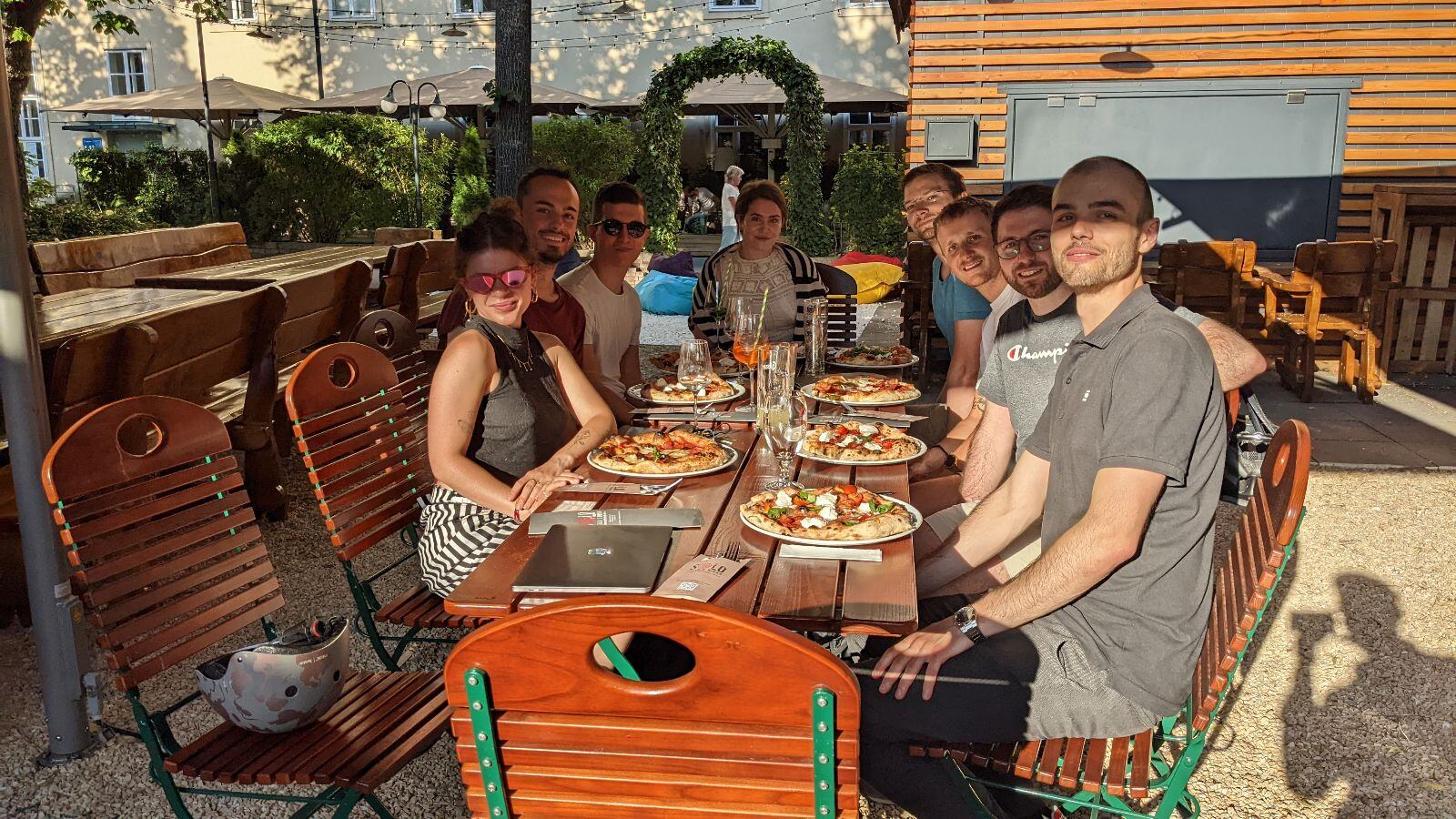This is our Diversity and Inclusion Journey
The lack of diversity in tech remains a problem - our industry has a long way to go. Equally, we as a team are conscious of what we must do. We are working to be part of this change and to be a leader in championing equality, diversity, and inclusion in everything we do and offer to our team, customers, and community.
& is committed to developing and fostering a culture of diversity within an unbiased and equitable workplace where everyone is respected and valued. We know we must do better to make & a more diverse and inclusive workplace. Before we dive deeper into our observations, here are some thoughts and facts about diversity and inclusion.
A sensitive topic
Feelings and opinions are involved.
A trending topic
There is a lot of noise, and it's hard to pinpoint the essence.
Always relevant
This is not a new but renewed topic.
Everyone is biased
Every company is at risk of becoming less diverse and inclusive.
DEI is not just about gender or race
So focusing on just those aspects can limit your thoughts on this topic.
Why are we bothered about diversity?
DEI is vital to us because it's our responsibility as entrepreneurs and leaders to create an environment that is safe, empowering, and inspiring for everyone around us. Promoting diversity, equality, and inclusion is the ethical path to take in an unjust world - so we do it.

Moreover, diverse teams create innovative solutions, such as software solutions to complex business problems. That's how we at & add meaning to our customers' everyday lives—through our teams that focus on developing and implementing high-quality software products tailored to every customer's specific needs.
But although it is clear that DEI is an instrument that serves the business interest of companies, there is still a lot of catching up to do. Despite mounting evidence of the benefits of having diverse perspectives in leadership positions, organizations still need to recruit and retain people with diverse backgrounds in technical fields. Research has linked greater diversity at these levels to enhanced financial performance [1], improved stock market returns [2], and higher hedge fund gains [3]. Furthermore, an investigation by Woolley and Malone revealed that teams composed more heavily of people with diverse backgrounds tended to display increased collective intelligence compared with those less balanced on this scale [4].
While research suggests equal STEM aptitude between men and women, it's been hypothesized that the lack of diversity within this field might be attributed to a societal belief that some males have an intrinsic talent for technical work. This idea has far-reaching implications for how we perceive technological expertise across genders.
Our society's pervasive beliefs have created a climate driving women out of the tech industry at an alarming rate – 45% higher than men [5]. This trend, unfortunately, also affects underrepresented minorities. Reports suggest they face harassment, microaggressions, and unequal pay [6].
What are we doing to increase diversity?
Before founding the company
External consulting on the topic of salary bands
Even before andamp GmbH was founded, initial thoughts were given on diversity. While some service companies use the first weeks and months exclusively to acquire customers and employees, we sought advice from an external expert and tried to lay various foundations right from the start.
How do we need to structure our company so that it treats different people with different characteristics and skills fairly?
How can we structurally ensure that we recognize and promote talents regardless of their characteristics and abilities, even if recruiting and leadership no longer depend on a few selected individuals?
How can we ensure people receive the same salary for the same work?
The expert
Anna Weiter, studied work, organizational and gender sociology in Munich, Nuremberg and Belgium: "In my final thesis, I researched the advantages and disadvantages of agile project work for software developers (spoiler: Holding all Scrum meetings does not mean you are working agile). After working in the recruitment of software developers in a management consultancy and in IT project management since 2022, I have been working in my dream job as an Agile People Lead, i.e. as an Agile Coach with Personal Development/Disciplinary Responsibilities."

In the role of Agile People Lead, Anna guides and supports multiple product development teams in mastering Agile methodologies and effective people management. Her efforts empower these teams to innovate, exceed customer expectations efficiently, and prioritize both personal and professional development. She cultivates a workplace where trust, learning, and growth on technical and personal levels are integral to the daily routine. Additionally, Anna addresses and examines structures of social discrimination, ensuring these issues are transparently and sustainably managed within the company. Through this dedication, she ensures that agility and diversity are not just buzzwords, but catalysts for necessary transformations both within and beyond the workplace.
The result
The discussion with Anna resulted in the first version of our skill levels and salary band. Important key takeaways that led to this were:
Salary should not be linked to formal education. People have different opportunities to complete different training courses due to different conditions. It would not be fair to only invite people to an interview who have completed specific training courses. We also want the best talent in our teams, not people with the best certificates. Neither salary nor initial classification in the interview process is linked to formal training. University degrees and prescribed university curricula help us better assess candidates' skills. Still, they do not prevent us from inviting people who have learned their skills through other means and putting them all through their paces.
Career development is the company's responsibility! Employees are responsible for continuing their education, learning, and passing on what they have learned. & ensures everyone has the same opportunities to demonstrate what they have learned. This includes regular career development meetings, which are not requested by employees but are automatically organized and monitored by People Operations. No employee has to "ask" for a salary discussion because the regular career development discussions are an integral part of the career cycle and are initiated by People Operations. It is not the people who have the most "courage" to ask for promotions who are promoted, but the best in their field!
Software development is creative, and formulating expectations for certain roles is difficult. Nevertheless, the expectations associated with a certain salary should be written down. This helps us minimize our unconscious bias and ensure that employees with the same skills and contributions receive the same salary.
Even if career development and expectations are well-defined processes and written criteria, career development must be as individual as our employees. People need different formats, resources, and platforms to achieve the same goals. This type of promotion can only succeed through many conversations and good communication.
So, we started to write down what we expected for each skill level and tried to define a market-compliant salary for each skill level.
In the first year
Joint writing of a Code of Conduct
Having breakfast together has been a tradition from day one. Even before our monthly amptalks with breakfast, we took a few hours every four weeks to start the day together and work on our Code of Conduct. In changing constellations, we discussed what kind of behavior we expect and do not expect from our colleagues and what kind of behavior can lead to exclusion. Since drawing up our Code of Conduct, we have regularly reminded, revised, and detailed it at our offsites.



What we need to do better
Having a Code of Conduct is all good. Talking about it every few months is also essential to living it! However, we realize that it often fades into the background of everyday working life. We are working on integrating the most essential content into various processes and everyday working life. If we don't do this better, the Code of Conduct risks becoming nothing more than a piece of paper.
In the second year
Skill levels revised
Since the initial launch, our skill levels have been revised and developed. Not just the founding members but various employees are involved in this process. Different focus areas, more precise formulations, and comprehensive descriptions have emerged. While the skill levels are constantly evolving, they have provided a very frequently used and good anchor for fair job interviews, salary grading, and career development since our second year.
Expectations are no longer written between the lines; they are written down and help promote the best employees rather than the most bullish ones.
Recruiting improved
We have realized how difficult it is to get to know people in a short space of time and to check and assess both cultural fit and skills. Likeability and factors like a similar history or experience, language, and daily state of mind can significantly influence questions and skills assessment. That's why we have started developing various questions and test cases. To ensure all interviews are similar, we have them prepared with different parameters and variations and put them together individually for each candidate. For each question we ask during interviews we know the expected answer in advance. This helps the interviewer to evaluate the answers with as little bias as possible.
The revised interviews should be the best trade-off between an individual approach to the candidate's previous CV and an unbiased assessment of skills without bias.
In the third year
Learning from professionals: factor-D
Results matter! It doesn't matter how great you can talk or what you do; the results count. The path to results is as individual as our employees. But the results are subject to precise requirements.
Our results could be better when talking about deeds, attempts, or not. The proportion of non-male employees has fluctuated between 8-18% in the first two years. The high fluctuation is because one non-male employee has a high impact on a team with a small number of employees. However, this is a miserable result compared to the overall population and when TU Wien graduates are taken as a reference value. After all, 18.6% of women graduate with computer science degrees. So, we have enlisted the help of professionals!
What does factor-D do?
factor-D Diversity Consulting is a leading consulting and training agency focused on DEI, Unconscious Bias, and Inclusive Leadership.
Participants
Over 4100 people from five continents participated in their training.
Training
They implemented 166 learning concepts tailored to the needs of their customers.
Consulting Projects
They consulted 15 organizations on developing or implementing their Diversity, Equity & Inclusion strategy.
E-Learnings
They implemented 71 E-Learning modules on Diversity, Equity & Inclusion for their customers.
What did we do?
We invited Dr. Hamscha and Mr. Wondrak from factor-D to work with us. The kick-off was an amptalk, during which Dr. Hamscha explained the terminology and current state of the science regarding diversity, equity, and inclusion. A campus talk focused specifically on women in technology and why society fails to produce a balanced proportion of female software developers. The most formative event, however, was a workshop with the two managing directors of factor-D. We worked on our unconscious bias and strategies to avoid it and improved our interview process.



Life&: Family, building a house, and other aspirations
A lot is expected of our employees. & offers interesting projects, plenty of training, and career opportunities. However, we are not known for taking it easy or being home early every day. A particularly quiet and non-time-consuming job must be separate from the demands we place on our work and our further training. However, we understand nobody can give 110% every day for many years or decades. Different aspects of life are important at different stages of life.
Discussions around the input of factor-D have also raised the question of how we deal with the different phases of life of different employees. While parents have a legal right to part-time [7] work and parental leave [8], an increasing number of people in the workforce do not want to or cannot aspire to a “traditional view of life and family”. We actively advise and support parents in reconciling work and family life within the scope of what is legally possible. In addition, we are committed to offering the same opportunities to everyone who works for us, whether they need a few months for themselves, are building a house, or have something completely different in mind. The following text from the Hans Böckler Foundation [9] explains why we do this:
“The growing plurality of working, living, and employment relationships makes it necessary to make working hours more flexible in the interests of employees, not just in terms of duration and location. The distribution of working hours over the year is also becoming increasingly important. Sabbaticals or short-term sabbaticals are worthwhile and, at the same time, practical everyday instruments for employees to distribute working hours based on their life phases and needs. H. Sabbatical variants with a shorter or medium term. A few years ago, it was almost exclusively teachers or university professors who were able to take advantage of the opportunity to take professional breaks - within the framework of a school year or semester - but many employees are increasingly interested in occasional breaks in the middle of their lives, which give them more should provide freedom than just a few free days or weeks at a time (cf. Klenner et al. 2003). There is the father who wants to accompany his child as he gets used to daycare or the employee whose parents have become in need of care and for whom the statutory care leave is insufficient. In addition, countless parents are familiar with the problem of school vacation periods that are far too long compared to their own vacation entitlements and that have to be compensated for somehow. However, the desire for longer training or a longer stay abroad is also causing more and more employees to express the need for a temporary exit from their professional lives. Here, sabbaticals could help to solve compatibility problems and alleviate time constraints.”
We aim to offer a workplace that challenges, encourages, and supports employees over many years or even decades.
In the fourth year
What will we do?
Implementing visual reminders on our Campus
Establish pro-active communication channels with underrepresented groups of people
Structure promotion of women in the company
Actively extending our recruiting pools to underrepresented groups of people
A long way to go
The tasks at hand are complex and far from being solved. From policymakers at the EU level to regional politicians, companies, and interest groups, to individuals, all people, regardless of their characteristics or how or where they were born, who want to make our society a better place for their fellow human beings, but also for themselves, are asked to do their part. & has already put a lot of energy and work into creating a diverse environment, both out of a social aspiration to offer a reasonable and fair workplace and out of its interest in having high-performance teams. This work needs to be completed; much more energy will be needed to achieve better results.
Become a cultural ̶f̶i̶t̶ add-on
Our employees do not represent the social average of our Viennese environment or the universities where we actively recruit. Almost everyone at & recognizes this as a challenge, and despite our efforts, the teams regularly ask us to continue investing time and energy to address it. No Company Retro goes by without discussing diversity and formulating new measures. And that's a good thing! We are looking for cultural fits and, above all, cultural add-ons! Could that be you?
[1] McGregor, Jena. “More Women at the Top, Higher Returns.” Washington Post. September 24, 2014
[2] Covert, Bryce. “Companies with Female CEOs Beat the Stock Market.” ThinkProgress. July 8, 2014
[3] Covert, Bryce. “Returns for Women Hedge Fund Managers Beat Everyone Else’s.” ThinkProgress. January 15, 2014
[4] Woolley, Anita, and T. Malone. “Defend Your Research: What Makes a Team Smarter? More Women.” Harvard Business Review (June 2011)
[5] Quora. “Why Women Leave the Tech Industry at a 45% Higher Rate Than Men.” Forbes. February 28, 2017
[6] Mundy, Liza. “Why Is Silicon Valley so Awful to Women?” The Atlantic. April 2017. Why Is Silicon Valley So Awful to Women?
[7] https://www.oesterreich.gv.at/themen/arbeit_und_pension/elternkarenz_und_elternteilzeit/Seite.3590004.html
[8] https://www.oesterreich.gv.at/themen/arbeit_und_pension/elternkarenz_und_elternteilzeit/Seite.3590007.html
[9] https://www.boeckler.de/fpdf/HBS-007590/p_fofoe_WP_170_2020.pdf

